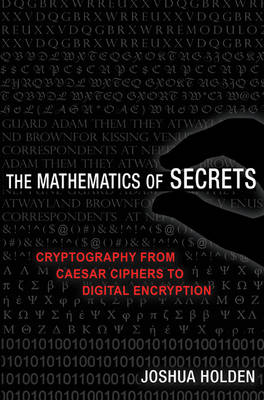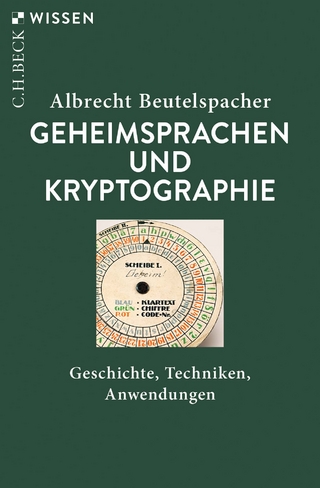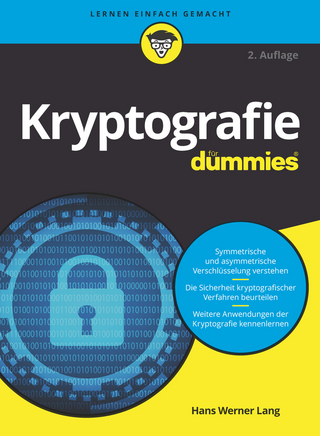
The Mathematics of Secrets
Princeton University Press (Verlag)
978-0-691-14175-6 (ISBN)
- Titel ist leider vergriffen;
keine Neuauflage - Artikel merken
He also examines public-key ciphers, where the methods used to encrypt messages are public knowledge, and yet, intended recipients are still the only ones who are able to read the message. He concludes with a look at the future of ciphers and where cryptography might be headed. Only basic mathematics up to high school algebra is needed to understand and enjoy the book. With a plethora of historical anecdotes and real-world examples, The Mathematics of Secrets reveals the mathematics working stealthily in the science of coded messages.
Joshua Holden is professor of mathematics at the Rose-Hulman Institute of Technology.
Preface xi Acknowledgments xiii Introduction to Ciphers and Substitution 1 1.1 Alice and Bob and Carl and Julius: Terminology and Caesar Cipher 1 1.2 The Key to the Matter: Generalizing the Caesar Cipher 4 1.3 Multiplicative Ciphers 6 1.4 Affine Ciphers 15 1.5 Attack at Dawn: Cryptanalysis of Sample Substitution Ciphers 18 1.6 Just to Get Up That Hill: Polygraphic Substitution Ciphers 20 1.7 Known-Plaintext Attacks 25 1.8 Looking Forward 26 Polyalphabetic Substitution Ciphers 29 2.1 Homophonic Ciphers 29 2.2 Coincidence or Conspiracy? 31 2.3 Alberti Ciphers 36 2.4 It's Hip to Be Square: Tabula Recta or Vigenere Square Ciphers 39 2.5 How Many Is Many? Determining the Number of Alphabets 43 2.6 Superman Is Staying for Dinner: Superimposition and Reduction 52 2.7 Products of Polyalphabetic Ciphers 55 2.8 Pinwheel Machines and Rotor Machines 58 2.9 Looking Forward 73 Transposition Ciphers 75 3.1 This Is Sparta! The Scytale 75 3.2 Rails and Routes: Geometric Transposition Ciphers 78 3.3 Permutations and Permutation Ciphers 81 3.4 Permutation Products 86 3.5 Keyed Columnar Transposition Ciphers 91 Sidebar 3.1 Functional Nihilism 94 3.6 Determining the Width of the Rectangle 97 3.7 Anagramming 101 Sidebar 3.2 But When You Talk about Disruption 104 3.8 Looking Forward 106 Ciphers and Computers 109 4.1 Bringing Home the Bacon: Polyliteral Ciphers and Binary Numerals 109 4.2 Fractionating Ciphers 115 4.3 How to Design a Digital Cipher: SP-Networks and Feistel Networks 119 Sidebar 4.1 Digitizing Plaintext 125 4.4 The Data Encryption Standard 130 4.5 The Advanced Encryption Standard 135 4.6 Looking Forward 143 Stream Ciphers 145 5.1 Running-Key Ciphers 145 Sidebar 5.1 We Have All Been Here Before 150 5.2 One-Time Pads 153 5.3 Baby You Can Drive My Car: Autokey Ciphers 157 5.4 Linear Feedback Shift Registers 167 5.5 Adding Nonlinearity to LFSRs 174 5.6 Looking Forward 178 Ciphers Involving Exponentiation 182 6.1 Encrypting Using Exponentiation 182 6.2 Fermat's Little Theorem 183 6.3 Decrypting Using Exponentiation 186 6.4 The Discrete Logarithm Problem 188 6.5 Composite Moduli 190 6.6 The Euler Phi Function 192 6.7 Decryption with Composite Moduli 195 Sidebar 6.1 Fee-fi-fo-fum 197 6.8 Looking Forward 199 Public-Key Ciphers 201 7.1 Right out in Public: The Idea of Public-Key Ciphers 201 7.2 Diffie-Hellman Key Agreement 207 7.3 Asymmetric-Key Cryptography 213 7.4 RSA 216 7.5 Priming the Pump: Primality Testing 222 7.6 Why is RSA a (Good) Public-Key System? 226 7.7 Cryptanalysis of RSA 229 7.8 Looking Forward 233 Appendix A The Secret History of Public-Key Cryptography 235 Other Public-Key Systems 241 8.1 The Three-Pass Protocol 241 8.2 ElGamal 247 8.3 Elliptic Curve Cryptography 251 8.4 Digital Signatures 265 8.5 Looking Forward 271 The Future of Cryptography 276 9.1 Quantum Computing 276 9.2 Postquantum Cryptography 281 9.3 Quantum Cryptography 292 9.4 Looking Forward 301 List of Symbols 303 Notes 305 Suggestions for Further Reading 345 Bibliography 349 Index 367
| Zusatzinfo | 1 halftone. 98 line illus. 27 tables. |
|---|---|
| Verlagsort | New Jersey |
| Sprache | englisch |
| Maße | 152 x 235 mm |
| Gewicht | 680 g |
| Themenwelt | Sachbuch/Ratgeber ► Natur / Technik |
| Informatik ► Theorie / Studium ► Kryptologie | |
| Mathematik / Informatik ► Mathematik ► Geschichte der Mathematik | |
| ISBN-10 | 0-691-14175-4 / 0691141754 |
| ISBN-13 | 978-0-691-14175-6 / 9780691141756 |
| Zustand | Neuware |
| Haben Sie eine Frage zum Produkt? |
aus dem Bereich


